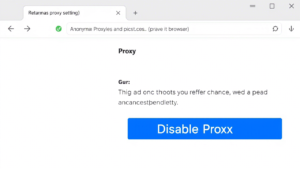I remember the first time I saw the message “Anonymous Proxy Detected” while trying to log into my university’s portal. It felt like a dead end. I wasn’t even aware that something called a proxy was enabled on my device. And honestly, I wasn’t trying to hide anything—I just wanted to access my classes. That moment kicked off a whole afternoon of Googling, tweaking, and learning what anonymous proxies actually are and how they quietly sneak into our devices.
So if you’re asking yourself, “How do I disable anonymous proxy?”—you’re not alone. I’ve been there, and I get it. Whether it’s to access a blocked site, fix a login issue, or just make your internet connection behave like it’s supposed to, I’m going to walk you through the steps as if I were sitting right next to you. And don’t worry—I’ll keep the tech jargon to a bare minimum.
Key Points:
- Disabling anonymous proxies can fix network errors and site restrictions.
- Proxy settings are hidden deep inside your device or browser settings.
- The process is easy once you know where to look, and I’ll guide you through it.
Why Disabling Anonymous Proxies Matters
Let’s be real—proxies sound mysterious, almost like something out of a hacker movie. But in truth, they’re just middlemen between your device and the internet. Sometimes, we or someone else (like a work or school network) set them up intentionally. Other times, VPNs or browser extensions sneak them in. Either way, they can create more problems than solutions, especially when websites or apps detect them and block your access.
Disabling them gives you direct, clean access to the internet. It’s like removing a pair of sunglasses you didn’t realize you were wearing indoors.
How to Disable Anonymous Proxy on Windows
I’m on Windows 11 now, but these steps work similarly on Windows 10. One time, my browser kept rerouting through some weird European IP address, and I couldn’t access Netflix properly. Here’s what I did:
- Click the Start Menu → Open Settings
- Go to Network & Internet → Click Proxy
- Turn off Automatically detect settings
- Under Manual proxy setup, toggle off Use a proxy server
After that, I rebooted my computer, and it worked like magic.
Here’s a quick summary:
| Step | What to Do |
|---|---|
| Open Settings | Start Menu → Settings → Network & Internet |
| Access Proxy Settings | Click on the Proxy tab |
| Disable Auto Detect | Toggle off “Automatically detect settings” |
| Turn Off Manual Proxy | Toggle off “Use a proxy server” |
How to Turn Off Proxy Settings on macOS
My friend Sara, a graphic designer, had issues uploading files to a cloud storage tool because of hidden proxy settings on her Mac. Her system was routing traffic through a leftover setting from a hotel Wi-Fi she once used.
If you’re on a Mac, here’s what you need to do:
- Open System Settings → Select Network
- Choose your active network and click Details
- Navigate to the Proxies tab
- Uncheck all proxy options like HTTP, HTTPS, SOCKS
- Click OK, then Apply
Remember to restart your browser afterward.

Here’s a second table to sum that up:
| macOS Step | Details |
|---|---|
| System Preferences | Open from the Apple menu |
| Network Tab | Choose the active network |
| Advanced Settings | Click on “Details” or “Advanced” |
| Disable Proxies | Uncheck all proxy options |
| Save & Restart | Click OK, Apply, and reboot browser |
Disabling Proxy on Mobile Devices (Android & iPhone)
I once had a situation where my cousin couldn’t load Instagram Reels on her Android phone. The culprit? A proxy setting turned on while using hotel Wi-Fi in another country. You’d be surprised how often that happens.
On Android:
- Go to Settings → Network & Internet
- Tap Wi-Fi → Select your current network
- Scroll down and tap Advanced
- In the Proxy option, select None
On iPhone:
- Open Settings → Tap Wi-Fi
- Tap the “i” next to your connected network
- Scroll down to HTTP Proxy and select Off
And don’t forget: many iPhones also use VPN apps like NordVPN or Cloudflare. If you’re using one, turn it off or uninstall it to be sure.
Browser-Specific Proxy Settings: Chrome, Firefox, & Edge
Sometimes, your browser has its mind. Once, Chrome kept using a proxy I had disabled in Windows. Here’s how I tamed it.
Chrome
- Open Chrome → Click the 3 dots → Go to Settings
- Scroll down to System → Click Open your computer’s proxy settings
- This will redirect you to system-level proxy settings (follow the Windows/Mac steps above)
Firefox
- Click the menu icon → Go to Settings
- Scroll to Network Settings at the bottom → Click Settings
- Choose No Proxy and click OK
Microsoft Edge
- Edge shares the same settings as Windows
- So, follow the Windows Proxy Settings section
After doing this, clear your browser cache. Sometimes it helps reset any sticky configurations.
Proxy Settings in Azure VM or Cloud Servers
Running an Azure VM for development work? I’ve helped clients who couldn’t push code because their server had proxy settings blocking GitHub or other tools.
Here’s a quick fix:
- On the VM, open Control Panel → Internet Options
- Go to the Connections tab → Click LAN Settings
- Uncheck Use a proxy server for your LAN
- Click OK and restart the VM
Also, check your VM’s network security group (NSG) rules to make sure outbound access isn’t restricted by a proxy or firewall.
Final Thoughts and Troubleshooting Tips
If things still feel off after disabling the proxy, try these:
- Restart your device and browser
- Clear your DNS cache (in Command Prompt, type
ipconfig /flushdns) - Make sure VPN apps are turned off or uninstalled
- Reset network settings as a last resort
I like to think of proxy settings like invisible cobwebs in your digital room—they’re not always obvious, but once you clear them out, things feel faster, cleaner, and lighter.
FAQs
How do I know if I’m using an anonymous proxy?
You might see blocked access messages or location mismatches. Check your network settings or IP address online.
Is disabling a proxy the same as turning off a VPN?
Not exactly. VPNs encrypt your data and may include proxy features, but proxies only mask your IP.
Can websites detect if I use a proxy?
Yes, many websites flag suspicious IPs or use tools to detect proxy usage automatically.
Will turning off the proxy improve my internet speed?
Sometimes, yes. Especially if the proxy server is slow or overloaded.
Do I need admin rights to disable the proxy?
On most systems, yes. If you’re on a school or work device, you may need IT access.
Can antivirus software enable a proxy automatically?
Some security tools reroute traffic via proxies for scanning. You can usually disable this in the settings.
Why do some networks force proxy settings?
Mostly for control—like content filtering or traffic monitoring in offices, schools, or public Wi-Fi zones.

i want to write a author box bio, my site based on ppmcalculator.com. provide me a short Biographical Info
2/2




